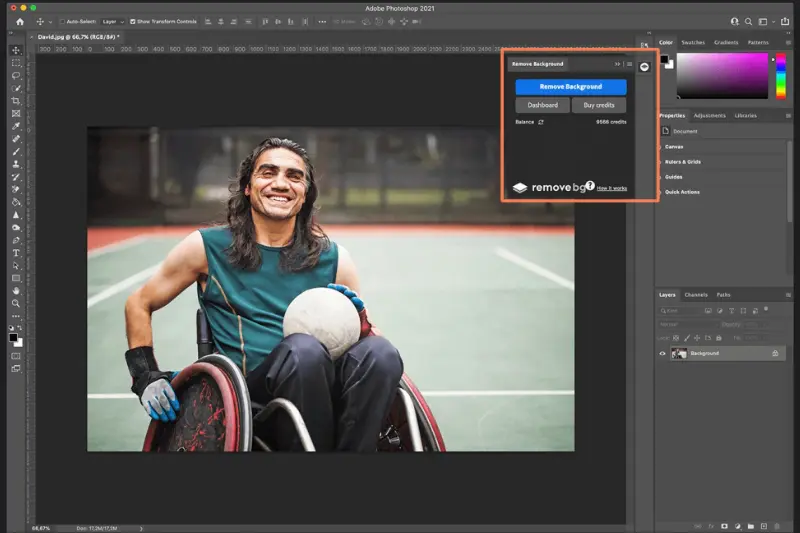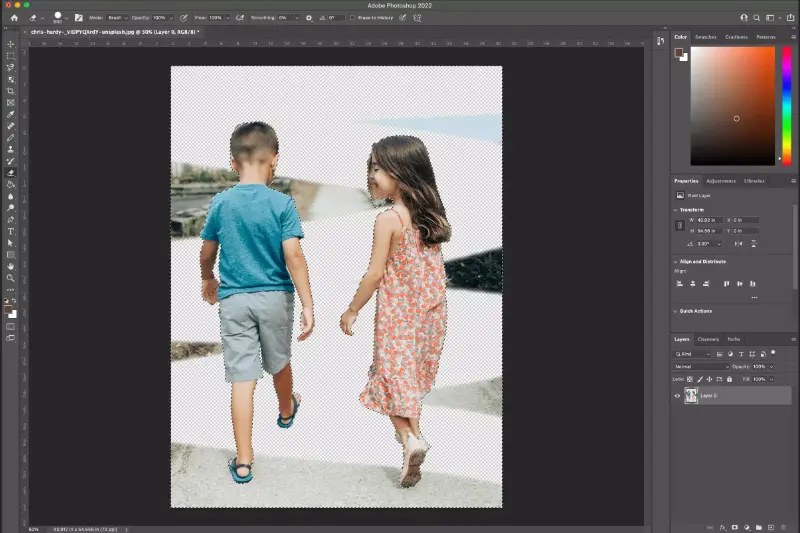How to Make Background Transparent in Photoshop?
Are you ready to elevate your images to the next level? Discover how to make backgrounds transparent in Photoshop with our comprehensive guide effortlessly. Whether you're a seasoned designer or just starting, mastering this technique can significantly enhance the visual appeal of your photos and designs. Imagine having the power to seamlessly remove backgrounds from any image, leaving your subjects crisp and isolated.
With Photoshop's advanced tools and our expert tips, achieving a transparent background has never been easier. Whether you're refining product photos for an online store or perfecting personal projects, this skill opens up endless creative possibilities. This guide will walk you through the step-by-step process of creating transparent backgrounds in Photoshop.
Each technique is designed to simplify your workflow and deliver professional-quality results, from selecting the right tools to refining edges with precision. Join countless designers and photographers who rely on Photoshop to bring their visions to life with clarity and impact. Ready to transform your images with ease? Dive into our detailed tutorial and discover how to make background removal a seamless part of your creative toolkit. Let's unlock the full potential of your photos together.
What Is A Transparent Background?
A transparent background refers to an image feature where the area around the main subject is see-through rather than filled with a solid color or pattern. In digital imaging, this effect is achieved by removing the background pixels while preserving the integrity of the foreground subject.
The result is a versatile image that can be seamlessly integrated into different backgrounds or compositions without any visible boundaries. Transparent backgrounds are commonly used in graphic design, photography, and digital art to enhance the appearance and versatility of images.
They allow the subject to stand out prominently without distractions, making them ideal for logos, product images, and creative designs where a clean, professional presentation is essential. This feature is precious in applications like Photoshop, where precise control over image layers and transparency levels can be achieved with various selection and masking tools.
Why Is A Transparent Background Useful?
A transparent background is instrumental for several reasons:
- Versatility: It allows you to place an image seamlessly onto any background without visible edges or boundaries. This flexibility is crucial in graphic design, allowing easy integration into different layouts and compositions.
- Professionalism: Transparent backgrounds enhance the professional appearance of images, particularly for product photos and logos. They remove distractions, ensuring the focus remains on the subject matter.
- Creative Freedom: Designers and artists benefit from the creative freedom transparent backgrounds offer. They can blend images into complex designs, create layered compositions, and experiment with various backgrounds without restrictions.
- Compatibility: Images with transparent backgrounds are compatible with various media and platforms, from websites and social media to print materials. They ensure consistency in appearance across different contexts.
- User Experience: For user-generated content or interactive applications, transparent backgrounds enhance user experience by seamlessly integrating images into different interfaces or environments.
In summary, transparent backgrounds provide versatility, professionalism, creative freedom, compatibility, and improved user experience, making them indispensable in digital imaging and design.
How To Make Background Transparent In Photoshop?
To remove the background and create transparency in Photoshop, start by opening your image and selecting the subject using tools like the Magic Wand or Quick Selection. Once selected, refine the edges with the Refine Edge tool for precision.
Next, add a Layer Mask to hide the background, leaving only the subject visible. Fine-tune as needed using the Brush tool on the mask. Finally, save your image in a format that supports transparency, such as PNG. This process ensures your subject stands out on any background, perfect for professional presentations and creative projects.
Step 1 - Use the quick action “Remove Background” tool available in Photoshop to remove background in just a few clicks.

Step 2 - Do a little more labor and remove the background manually to get things done perfectly.

Quick Action To Remove Backgrounds Transparently In Photoshop
In Photoshop, swiftly removing backgrounds to achieve transparency is crucial for digital artists, photographers, and graphic designers. This quick action enables you to seamlessly isolate subjects from their backgrounds, creating versatile images that can be integrated into various projects.
Using powerful selection tools like the Magic Wand or Quick Selection and refining techniques like the Refine Edge tool allows for precise and clean cutouts. Adding a layer mask refines the process further, ensuring seamless transitions and accurate transparency around the subject.
This capability is invaluable for professionals looking to enhance the visual appeal of their designs, whether for product photos, marketing materials, or creative compositions. Photoshop's intuitive interface and robust editing capabilities make achieving professional-quality transparent backgrounds accessible, empowering users to elevate their artwork quickly and precisely.
Step 1 - Open the image and create another layer of the image in Photoshop. You can create this layer by selecting the entire image (CTRL+A), copying it (CTRL+C), and finally pasting it (CTRL+V) over the opened image.

Step 2 - On the right side of your screen, find the "Layers" panel and click on the "eye" button that you see in the "background layer" option in that panel. This will hide the image's background, and you will only be working with the layer of the image you created in the previous step.

Step 3 - Next, go to the "Properties Panel" on the right side of the screen and find and click the "Quick Action" settings icon.

Step 4 - Find and click the "Remove Background" option in the further options.

Remove The Background From The Image Manually
In Photoshop, mastering the art of manually removing backgrounds to create transparent images is a fundamental skill for designers and photographers alike. This technique allows you to meticulously isolate subjects from their surroundings meticulously, ensuring clean and professional-looking results. You can accurately outline and separate the subject from the background by utilizing precise selection tools such as the Pen Tool or Quick Selection Tool.
Refining the edges using tools like Refine Edge or Select and Mask enhances the quality of the cutout, smoothing transitions and preserving fine details. Adding a layer mask lets you fine-tune the transparency, seamlessly integrating the subject into any desired background or composition.
This process enhances the visual appeal of images and provides creative flexibility, enabling diverse applications in graphic design, digital art, and photography. With Photoshop's comprehensive toolkit, achieving stunning transparent backgrounds empowers creators to craft compelling visuals tailored to their specific needs and artistic visions.
Top Photoshop Features For Removing Image Backgrounds
Creating a transparent background in Photoshop is a fundamental skill for designers, photographers, and digital artists. Adobe Photoshop offers a variety of features and tools that make the process of removing image backgrounds efficient and precise.
Whether you're working with product photos, portraits, or creative compositions, mastering these tools can significantly enhance your workflow and the quality of your final images.
1. Selection Tools
Photoshop provides several selection tools that are essential for isolating subjects from their backgrounds:
- Quick Selection Tool: Ideal for quickly selecting areas of similar color or tone.
- Magic Wand Tool: Useful for selecting areas with consistent color.
- Pen Tool: Offers precise control for creating paths and selections manually.
- Select Subject: Uses Adobe Sensei AI technology to select the main subject in the image automatically.
2. Refine Edge and Select and Mask
After making an initial selection, refining the edges is crucial to achieve a clean cutout:
- Refine Edge: This allows you to refine the selection edges and adjust feathering, smoothness, and contrast to create a natural transition between the subject and background.
- Select and Mask: Provides a dedicated workspace for refining selections with tools like the Brush Tool for edge refinement and the View Modes for previewing the selection against different backgrounds.
3. Layer Masks
Layer masks in Photoshop are indispensable for non-destructive editing:
- Layer Mask: Allows you to hide or reveal portions of a layer without permanently deleting pixels, making it easy to adjust selections and refine transparency.
- Mask Properties: Offers feathering, density, and contrast controls to fine-tune the transparency effect.
4. Blending Options
Photoshop's blending options enhance the integration of subjects into new backgrounds:
- Blend Modes: Alter how pixels in the active layer blend with underlying pixels, which helps create seamless transitions.
- Opacity: Adjusts the entire layer's transparency, controlling the subject's overall visibility.
5. Smart Objects and Smart Filters
Working with Smart Objects and Smart Filters allows for non-destructive adjustments and edits:
- Intelligent Objects: Preserve the original image data and allow re-editing adjustments without losing quality.
- Intelligent Filters: Apply filters to Smart Objects non-destructively, including blurs and sharpening effects, enhancing the overall appearance of your image.
6. Brush Tools for Masking
Customizable brush tools aid in detailed masking and refinements:
- Brush Tool: Allows you to paint on layer masks, adding or subtracting areas to refine transparency.
- Refine Edge Brush Tool: Smooths edges and improves the transition between foreground and background.
7. Content-Aware Fill
Photoshop's Content-Aware Fill feature intelligently fills in the background area after removing the subject:
- Content-Aware Fill: Automatically fills the background area with surrounding pixels, seamlessly blending with the subject.
8. Actions and Batch Processing
Automate repetitive tasks and streamline your workflow with Photoshop Actions and Batch Processing:
- Actions: Record and save a series of steps to apply to multiple images, saving time and ensuring consistency.
- Batch Processing: Apply Actions to a batch of images, ideal for processing multiple photos with similar requirements.
9. Export Options
Efficiently save and export your images with transparency:
- Save as PNG: Preserve transparency when saving images for web or print.
- Save for Web: Optimize file size and quality for online use, maintaining transparency.
Tips For Perfecting Transparent Backgrounds
Creating transparent backgrounds in Photoshop is crucial for enhancing images, whether for professional presentations or creative projects. This process allows you to isolate subjects seamlessly, making them versatile for applications like web design, product photography, or digital art.
Mastering transparent backgrounds involves precise selection, refining edges, and maintaining natural transitions between foreground and background elements. With the proper techniques and attention to detail, you can achieve polished results that elevate the visual impact of your images. In this guide, we'll explore essential tips and features in Photoshop to help you perfect the art of transparent background creation.
Start with a High-Quality Image
Starting with a high-quality image is crucial when aiming for a transparent background in Photoshop. High resolution and sharp details make selecting and refining edges easier, resulting in cleaner and more accurate transparency. The clarity of the initial image also ensures that the subject stands out distinctly against any background it's placed on.
Whether for professional photography or personal projects, beginning with a well-exposed and sharp image sets the foundation for achieving seamless and professional-looking transparent backgrounds in Photoshop.
Use Selection Tools Wisely
Using selection tools wisely in Photoshop is essential for achieving accurate and precise transparent backgrounds. Experiment with the Quick Selection Tool, Magic Wand, and Pen Tool to find the best fit for your specific image. The Quick Selection Tool is excellent for quickly grabbing large areas, while the Magic Wand can efficiently select areas of similar color.
For intricate details and precise selections, rely on the Pen Tool, allowing you to create smooth, adjustable paths. Mastering these tools ensures you can effectively isolate subjects from their backgrounds, laying the groundwork for seamless transparency adjustments.
Refine Edges Carefully
Carefully refining edges in Photoshop is crucial for achieving polished and professional transparent backgrounds. After making an initial selection using tools like the Quick Selection Tool or Pen Tool, refine edges using features like Refine Edge or Select and Mask. These tools allow you to adjust edge detection, smoothness, feathering, and contrast to ensure smooth transitions between the subject and background.
Pay attention to details, zoom in for precision, and use techniques like painting with the Refine Edge Brush to refine complex areas like hair or intricate objects. This meticulous approach enhances the overall quality and realism of your transparent backgrounds.
Adjust Feathering and Contrast
Adjusting feathering and contrast in Photoshop is crucial for creating natural-looking transparent backgrounds. Feathering refers to softening the edges of a selection, which helps blend the subject seamlessly into a new background. In the Select and Mask workspace or through the Feather option in the Properties panel, adjust the feather radius to control the softness applied to the edges.
Contrast adjustment is essential to ensure that the subject stands out distinctly against any background. Use adjustments like Levels or Curves to fine-tune the contrast between the subject and the background, enhancing clarity and definition. Balancing feathering and contrast ensures that your transparent backgrounds look realistic and professionally polished, suitable for various design and photography applications.
Utilize Layer Masks
Layer masks in Photoshop are essential for creating precise, non-destructive, transparent backgrounds. After selecting the subject, apply a layer mask to hide unwanted areas of the image while preserving the original pixels. Use the Brush Tool with black to hide and white to reveal parts of the layer mask, allowing for seamless adjustments and corrections.
Layer masks offer flexibility to refine edges, adjust transparency levels, and experiment with different background options without permanently altering the image, ensuring a professional and polished final result.
Check Opacity and Blend Modes
Checking opacity and blend modes in Photoshop is crucial for fine-tuning transparent backgrounds. Adjust the opacity of your subject layer to control its transparency, allowing it to blend naturally with any background. Experiment with blend modes like Multiply, Screen, or Overlay to achieve different effects and enhance the interaction between your subject and the new background.
Understanding how opacity and blend modes affect the overall composition helps create visually appealing, seamless, transparent backgrounds that integrate well into various design projects.
Use Smart Objects for Flexibility
Using Smart Objects in Photoshop enhances flexibility when creating transparent backgrounds. Convert your image layer into a Smart Object to preserve its original quality and attributes while applying transformations or adjustments. This non-destructive workflow allows you to revisit and refine edits without losing image quality.
When removing backgrounds, convert the selection into a Smart Object before applying adjustments like blur or sharpen filters. This method retains flexibility in editing, ensuring that your transparent backgrounds maintain high quality and adaptability for different design needs. Smart Objects are essential for maintaining workflow efficiency and achieving professional results in Photoshop.
Employ Brush Tools for Detailing
Employing brush tools in Photoshop is crucial for detailed work when refining transparent backgrounds. Use the Brush Tool with soft edges and varying opacity to paint on layer masks carefully. This allows for precise adjustments, especially around intricate areas like hair or delicate textures.
Adjust the brush size and hardness to suit different parts of the image, ensuring smooth transitions between the subject and background. By meticulously painting on layer masks, you can achieve seamless and professional-looking transparent backgrounds, enhancing your images' overall quality and realism in Photoshop.
Consider Content-Aware Fill
Consider using Content-Aware Fill in Photoshop to remove backgrounds seamlessly. After selecting your subject, go to Edit > Content-Aware Fill. This powerful feature analyses the surrounding pixels and intelligently fills the selected area with similar content, removing the background.
Adjust the Content-Aware Fill workspace settings to refine results and ensure a smooth transition between the subject and the new background. Content-Aware Fill is beneficial for complex backgrounds or areas where manual editing may be challenging, providing a quick and effective method to achieve transparent backgrounds in Photoshop.
Save in PNG Format
Save your images with transparent backgrounds in PNG format in Photoshop to preserve transparency. PNG format supports alpha transparency, allowing you to maintain the background-free areas of your image. This ensures that when you place your image into other projects or applications, the background remains transparent, seamlessly blending with any background color or design.
PNG format is widely supported and ideal for web use, printing, and digital designs where maintaining image quality and transparency is essential. Always choose PNG when saving images with transparent backgrounds in Photoshop to ensure optimal compatibility and quality retention.
Use AI Background Remover Tool like Erase.bg
Using an AI background remover tool like Erase.bg can significantly streamline the process of removing backgrounds in images. Unlike manual methods in Photoshop, Erase.bg leverages artificial intelligence to automatically detect and remove backgrounds with precision and speed. This tool employs advanced algorithms to analyze images and accurately separate subjects from their backgrounds, even in complex scenarios such as hair or fine details.
Erase.bg simplifies the workflow by eliminating the need for intricate selections and manual adjustments. Users can upload their images, and Erase.bg produces a clean, transparent background within seconds.
This AI-powered solution saves time and ensures consistent and professional results, making it ideal for photographers, designers, and anyone needing high-quality images for various applications. By harnessing the power of AI, Erase.bg provides a user-friendly experience that enhances productivity and facilitates creative freedom in image editing tasks.
Conclusion
Mastering transparent backgrounds in Photoshop enhances image quality and versatility, making your photos suitable for web use, digital designs, and more. With the proper techniques, you can achieve seamless transparency that integrates smoothly into different contexts, enhancing visual appeal and usability.
FAQ's
How do I remove a white background from transparent in Photoshop?
To remove a white background and create transparency in Photoshop, you can use the Magic Wand tool or the Quick Selection tool to select the white background, and then press the Delete key to remove it. Alternatively, you can use a layer mask to refine your selection and create a more precise edit.
How can I remove the white background from an image?
To remove the white background from an image using Erase.bg, follow these steps: Step 1: Go to the Erase.bg website and upload your image by clicking the "Upload Image" button. Step 2: Once your image is uploaded, Erase.bg will automatically remove the background and show you a preview of the result. Step 3: Once you're happy with the result, click the "Download" button to save your edited image.
How do I make my background transparent?
To make your background transparent using Erase.bg, follow these steps: Step 1: Go to the Erase.bg website. Step 2: Upload your image by clicking the "Upload Image" button. Step 3: Once your image is uploaded, Erase.bg will automatically remove the background and show you a preview of the result. Step 4: Then click the "Download" button to save your edited image as a transparent PNG file.
What is the easiest way to make a background transparent in Photoshop?
The easiest way to make a background transparent in Photoshop is to use the Magic Wand tool to select the background, then delete it. You can also use the Background Eraser tool or the Select and Mask tool to refine your selection.
How do I save an image with a transparent background in Photoshop?
To save an image with a transparent background in Photoshop, go to File > Save As and choose a format that supports transparency, such as PNG. Make sure to check the "Transparency" option before saving.
Are there any online tools to make a background transparent as good as Photoshop?
While Photoshop is the industry standard for image editing and background removal, there are some online tools that can similar results, such as Erase.bg. This tool uses AI-powered algorithms to automatically remove backgrounds and make them transparent.